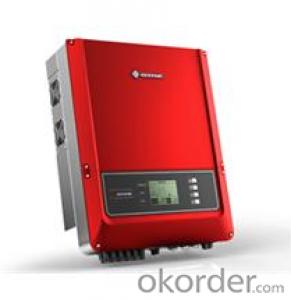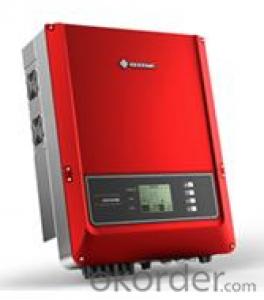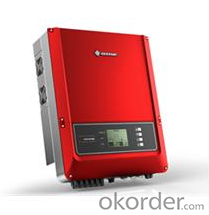220 Solar Inverter GW17K-DT On Grid Solar Inverter
- Loading Port:
- Shanghai
- Payment Terms:
- TT OR LC
- Min Order Qty:
- 10 unit
- Supply Capability:
- 100 unit/month
OKorder Service Pledge
OKorder Financial Service
You Might Also Like
GW17K-DT
GW17K-DT photovoltaic inverter is suitable for commercial and industrial roofs as well as small and medium-sized photovoltaic power systems. The optimized inductor design ensures less noise and higher European efficiency. The reliable grid support capabilities, high waterproof and dustproof grade and extra-wide voltage access range of components not only can be used in commercial roof and commercial power station systems, but also is qualified for the design requirements of large-megawatt power station.
| DC Input Data | Max.PV-generator power[W] | 17500 |
| Max.DC voltage[V] | 1000 | |
| MPPT voltage range[V] | 500~800 | |
| Turn on DC voltage[V] | 250 | |
Max.DC work current[A] | 22/22 | |
| Number of inputs/MPP trackers | 6/2 | |
| DC connector | SUNCLIX,MC IV (optional) | |
| Standby power consumption [W] | 10 | |
| AC Output Data | Nominal AC power[W] | 17000 |
| Max.AC power[W] | 17000 | |
| Max.output current[A] | 25 | |
| Nominal output voltage range | VDE-AR-N4105,VDE0126-1-1/A1,RD1699,G59/2,AS4777.2/.3 | |
| AC grid frequency | VDE-AR-N4105,VDE0126-1-1/A1,RD1699,G59/2,AS4777.2/.3 | |
| THDi | <1.5%< td=""> | |
| Power factor | 0.90 leading...0.90 lagging | |
| AC connection | 3W/N/PE,230/400V | |
| Efficiency | Max.efficiency | 98.2% |
| European efficiency | 97.5% | |
| MPPT adaptation efficiency | >99.5% | |
| Safty Equipment | Leakage current monitoring unit | Integrated |
| DC switch disconnector | Optional | |
| Islanding protection | AFD | |
| Grid monitoring | VDE-AR-N4105,VDE0126-1-1/A1,RD1699,G59/2,AS4777.2/.3 | |
| Normative Reference | EMC compliance | EN 61000-6-1 , EN61000-6-2, EN 61000-6-3, EN 61000-6-4 |
| Safety compliance | IEC 62109-1, AS3100 | |
| General Data | Dimensions(W*H*D) [mm] | 516*650*203 |
| Net weight [kg] | 39 | |
| Housing | For outdoor and indoor | |
| Mounting information | Wall mounting | |
| Operating temperature range | -20~60℃(up 45℃ derating) | |
| Relative humidity | 0 ~ 95% | |
| Site altitude[m] | 2000 | |
| IP proection class | IP65 | |
| Topology | Transformerless | |
| Cooling | Fan Cooling | |
| Noise level[dB] | <45< td=""> | |
| Display | 5"LCD | |
| Communication | USB2.0;RS485/Wi-Fi/ZigBee(optional) | |
| Standard warranty[years] | 5/10/15/20/25(optional) |
- Q: How does a solar inverter handle voltage fluctuations from the grid?
- A solar inverter handles voltage fluctuations from the grid by constantly monitoring the voltage and adjusting its output accordingly. When the grid voltage increases or decreases, the inverter's control system regulates its own output voltage to match the changes, ensuring a stable and consistent supply of electricity is fed into the grid. This helps to maintain grid stability and protect the connected devices from potential damage caused by voltage fluctuations.
- Q: Are there any government incentives for installing a solar inverter?
- Yes, there are government incentives available for installing a solar inverter. Many countries and states offer various financial incentives, such as tax credits, rebates, grants, or low-interest loans to promote the adoption of renewable energy technologies like solar inverters. These incentives aim to encourage individuals, businesses, and organizations to invest in clean energy solutions and reduce their carbon footprint. It is advisable to check with local government authorities or renewable energy agencies to determine the specific incentives available in your area.
- Q: Are there any safety concerns associated with solar inverters?
- Yes, there are some safety concerns associated with solar inverters. The main concern is the risk of electrical shock or fire due to faulty installation, improper maintenance, or inadequate grounding. It is important to ensure that professional installation is done according to safety guidelines and that regular inspections and maintenance are carried out to mitigate these risks.
- Q: How is the output voltage of a solar inverter regulated?
- The output voltage of a solar inverter is regulated through the use of control circuitry and power electronics components. These components monitor the input voltage from the solar panels and adjust the output voltage to meet the desired specifications. The control circuitry ensures that the output voltage remains stable and within the required range, even when there are fluctuations in the input voltage or varying load conditions.
- Q: Do I need a special inverter for a battery storage system?
- Yes, a special inverter is required for a battery storage system. Unlike traditional solar inverters that convert DC power from solar panels into AC power for immediate use or for feeding back into the grid, a battery storage system inverter is designed to manage the charging and discharging of the batteries. It ensures that the stored energy is used efficiently and safely, and allows for backup power during grid outages.
- Q: What is the maximum DC input current for a solar inverter?
- The maximum DC input current for a solar inverter will depend on the specific model and specifications of the inverter being used. It is important to refer to the manufacturer's documentation or consult the product's technical specifications to determine the maximum DC input current for a particular solar inverter.
- Q: Can a solar inverter be used with solar-powered emergency backup systems?
- Yes, a solar inverter can be used with solar-powered emergency backup systems. A solar inverter is an essential component in converting the direct current (DC) generated by solar panels into alternating current (AC) that can be used to power appliances and devices. By connecting the solar inverter to a solar-powered emergency backup system, the excess solar energy can be stored in batteries or fed back into the grid, providing a reliable source of electricity during power outages or emergencies.
- Q: Can a solar inverter be used with different types of power conditioning units?
- No, a solar inverter is specifically designed to work with solar power conditioning units. It may not be compatible with other types of power conditioning units such as wind or hydro power systems.
- Q: Is the PV inverter a current source or a voltage source?
- According to the waveform modulation method can be divided into square wave inverter, stepped wave inverter, sine wave inverter and modular three-phase inverter.
- Q: Can a solar inverter be used with different types of grounding materials?
- Indeed, various grounding materials can be employed in conjunction with a solar inverter. Nevertheless, it is crucial to verify that the grounding system aligns with the manufacturer's prescribed specifications and guidelines for the specific solar inverter. The selected grounding materials must adhere to the essential safety standards and furnish adequate electrical grounding for the solar setup. It is advisable to seek guidance from a certified electrician or solar expert to ascertain the fitting grounding materials for your particular solar inverter and installation.
Send your message to us
220 Solar Inverter GW17K-DT On Grid Solar Inverter
- Loading Port:
- Shanghai
- Payment Terms:
- TT OR LC
- Min Order Qty:
- 10 unit
- Supply Capability:
- 100 unit/month
OKorder Service Pledge
OKorder Financial Service
Similar products
Hot products
Hot Searches
Related keywords
























